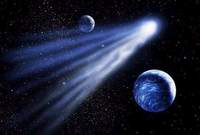Scientists discuss new version of Tunguska meteorite mystery
A blast over the taiga

A small comet or meteor is thought to have collided with the Earth’s atmosphere and exploded in the sky at about 7 a.m. local time on June 30, 1908. The impact took place at Tunguska in Central Siberia. The object is thought to have detonated some 5-10 kilometers above the ground. The blast felled millions of trees over an area of 2,200 square kilometers near the Tunguska River.
Scientists have been trying to solve the mystery of the greatest explosion of modern times ever since the first expedition reached the site in 1938.
Hypothesis
A University of Bologna team led by Professor Giuseppe Longo says it has identified a possible impact crater left by the giant cosmic body. The Italian scientists believe Lake Cheko located several kilometers of the airburst epicenter may be occupying a crater gouged out by a chunk of rock that hit the ground.
The scientists say Lake Cheko fits the proportions of a bowl-shaped impact crater, and therefore could be related to the Tunguska event. The lake is located in a very remote area. No conclusive evidence can be provided to confirm that the lake had existed before 1908. An impact-structure origin of the lake suggests the weight of a cosmic body could measure 1.5 by 106 kilos. The impact may have been produced by the remnant material of the object that exploded 5-10 kilometers above the ground.
The Bologna team says that a space rock may have traveled at a low speed and had a “soft” impact in the swampy taiga. The possibility could be responsible for a relatively low degree of damage to the surrounding area.
The lake was previously thought to have been formed by eruption of a volcano. The Italian scientists refuted the theory after conducting a geophysics survey of the lake. They are now considering a new origin of the lake. The research continues at the lake bed in an attempt to find pieces of a meteorite.
Experts speak out
Astronomer David Morrison at Ames Research Center believes the Longo hypothesis contradicts the laws of physics under which a larger object of a greater force is to generate a larger crater on impact. It seems strange that that one of the small fragments of the meteorite made it to the ground following the explosion, which, mysteriously, generated no larger crater whatsoever.
Alan Harris, a planetologist at Space Studies Center in Boulder, Colorado, suggests that the Longo hypothesis should be given further consideration. Professor Longo is a well-known authority on the Tunguska event. Harris cited the case of Sikhote Alin meteorite as an example. About one hundred small-sized craters were left by the meteorite’s fragments when they hittheground in 1947.
Unorthodox explanations of the Tunguska event
1930 – explosion of a comet’s solid nucleus
1932 – Earth’s collision with a compact cloud of space dust
1934 – Earth’s collision with a comet’s tail
1945 – an atomic explosion of a spaceship
1946 – a midair disaster of a spaceship from Mars
1947 – annihilation of a meteorite made of antimatter
1958 – impact of a meteorite made of ice
1959 – impact of a fragment of the planet Phaeton
1960 – detonation of a giant swarm of midges in an area exceeding 5 cubic kilometers.
1961 – disintegration of a flying saucer
1962 – an ionosphere electric breakdown caused by a comet
1963 – destruction of the taiga by a meteorite’s static charge
1964 – impact of a laser beam out of space
1965 – intrusion of a spaceship with a yeti on board
1966 – fallout of a super-solid fragment of a white dwarf
1967 - a marsh gas explosion caused by lightening
1968 – dissociation of water and oxyhydrogen gas
1969 – fallout of a comet made of antimatter
According to one of the quirkiest versions, the Tunguska event might have been caused by experiments conducted Nikola Tesla in his laboratory at Wardenclyffe Tower, near New York, approximately at a time when the disaster occurred. Tesla’s experiments aimed to transport electricity via the earth’s ionosphere.
In February 2007, Russian researchers from the city of Krasnoyarsk unveiled yet another version of the Tunguska event. According to them, an ice comet made of water and carbon fell into the taiga on June 30, 1908. Gennady Bybin, a physicist and leader of the Krasnoyarsk team, claims that pieces of pressed ice containing frozen combustible gases (ice was found on site 20 years later) have nothing to do with permafrost. Bybin believes ice specimens indicate evidence of a new theory. Numerous ice fragments of the comet struck the ground following the airburst. Earth turned out to be a red-hot frying pan for the ice which was melted or ground up by the impact, says Bybin.
Bybin’s hypothesis is based on the drawings from a diary by L.A.Kullik, head of a Soviet expedition that was the first to reach the site in 1938. According to Bybin, Kullik’s team found some ice-like substance covered with bog peat while inspecting the site. The Kullik team did not pay much attention to the find because they were searching for evidence of a classic meteorite, a stony or stony-iron variety of it. Bybin’s team already published a paper detailing the new hypothesis. The Krasnoyarsk researchers hope their version could help to solve the Tunguska mystery once and for all.
Nezavisimaya Gazeta
Translated by Guerman Grachev
Pravda.ru
Subscribe to Pravda.Ru Telegram channel, Facebook, RSS!

